Halberstadt CL.II
Operational History
The CL.II entered service in August 1917, and proved extremely successful, its excellent manoeuvrability, rate of climb and good field of fire for its armament allowing it to match opposing single-seat fighters. It also proved to be well suited to close-support, which became the primary role of the CL-type aircraft, the units operating them being re-designated Schlachtstaffeln (Battle flights).
Ground support by the Schlachtstaffeln proved very effective, being used both in support of German attacks and to disrupt enemy attacks. An early example of the successful use of CL type aircraft in the ground attack role was during the German counterattack on 30 November,1917 during the Battle of Cambrai, where they were a major factor in the German performance.
The success of the German tactics at Cambrai, including the use of close air support, resulted in the Germans assembling large numbers of CL-types in support of the Spring Offensive in March 1918, with 38 Schlachtstaffeln (equipped with the CL.II, CL.IV and the Hannover CL.III) available, of which 27 were deployed against the British forces during the initial attack in Operation Michael.. The CL.II continued in service until the end of the War.
The Kit
The 1/48 Mirage Hobby Halberstadt CL.II is available in two separate boxings, and the company also produce a CL.IV in this scale. The kit offers more than 270 parts in plastic and PE, although not every part is used. My kit cost about £40 including p/p.
The instructions are in booklet form, in colour, and include useful historic reference photographs.
The PE fret included a section of turnbuckle eyelets, but because of their flat profile I preferred an aftermarket alternative, in this case a selection from Bob's Buckles, consisting of eyelets of minutely fine wire and 0.05mm diameter brass tube in 2mm sections.
Rigging material is 0.06mm Reflo Powerline, the diameter of a human hair.
The German air crew figures are a resin set from Elan 13 Miniatures, and are nicely detailed.
As an additional reference, I used Windsock Datafile 27, Halberstadt CL.II, by PM Grosz (now OOP).
Other than to aficionados, Great War aircraft are sometimes viewed as curiosities, when in fact they were state-of-the-art air weapons, the Halberstadt itself the 1918-equivalent of the Fairchild Republic A-10.
With the advent of Wingnut Wings in recent years, the modelling trend has been towards 1/32 scale subjects, but with single-seat WnW subjects now fetching prices approaching £200, one has to ask oneself if there are other alternatives in quality and detail that still provide a rewarding modelling experience.
As a kit that is highly complex and arguably for experienced modellers only, I would recommend it on that basis. Certainly, in respect of quality and detailing, nothing can touch the Mirage Hobby Halberstadt series.

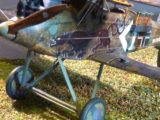
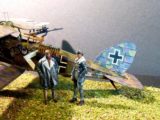
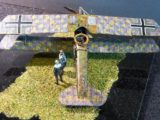
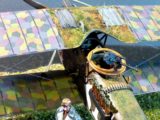
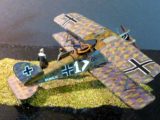
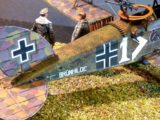
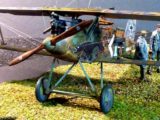
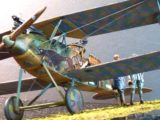
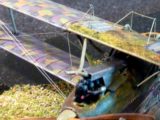
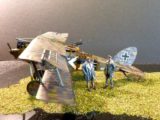
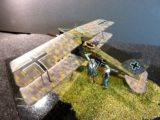
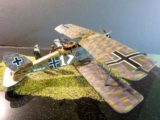

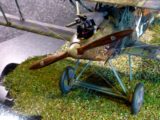
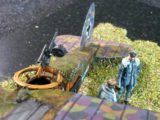
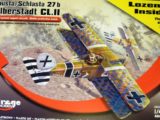
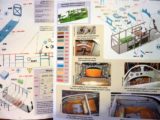


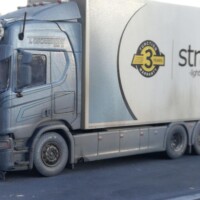
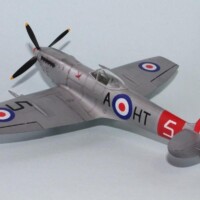
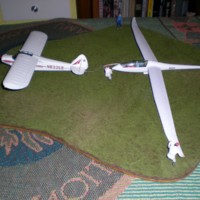
Well done, sir!
Sincerely, Vlad.
Thanks, Vlad.
Looks like a very high quality kit. I didn't even know that Mirage Hobby had such a gem in their line, how well does it fit together? The instruction booklet reminds me of Gaspatch 1/48 Salmson 2a2, another 1/48 kit of WnW quality which you might find interesting to check. And - lovely finish on the kit and that Lozenge. Well done
Thanks, Martin. The quality is certainly in evidence. The PE fret is a bonus, with highly detailed and useful additions to enhance the model.
I know what you mean about the Gaspatch subjects, and there is a similarity although the MH items predate those of Gaspatch by a few years, so arguably MH were ahead of their time. Copperstate is another firm that comes to mind, although their models seems quite delicate in comparison.
I mentioned it as a subject for experienced modellers. If you have experience of WW1 subjects and take your time it's manageable, but otherwise might be a bit of a handful.
I spent about 180 hours on it, which is a considerable amount of time for the scale and indicates the complexity of the build.
180 hours! That's not for the faint-hearted. I once estimated spening 40-60 hours per model on my WW2 builds. Think I'll be getting back to my Airfix Spitfire... lol
PS should mention that the Stielhandgranate M17 'stickbombs' are scratched but I think MH offer them as an aftermarket item.
That's super build Rob, really like the way it turned out, especially the figures. You have once again demonstrated why I don't build WWII subjects,
WWI Subjects
Cheers, Tom.
Great depiction of a mount of The Knights of the Air. I think you have brought out a feeling for the aircraft´s fragility combined with a sense of a technically complicated machine. Not too often one see that mottled camouflage, looks great.
Cheers, Stellan. The mottle for the fuselage and centre top wing was specific to the Halberstadt, and was applied at the factory. Irregular colour swatches of greens and mauve etc spatter-sprayed with a Sand colour. The kit provides a decal sheet for this but as I am a sane person I used close-textured sponges.
Great work, Rob! Your paintwork is very well done. It's not easy to get that pattern to look right.
Thanks, John. I think the colour palette of mottling and lozenge shades work well together on this subject.
Smashing !
Cheers, Phil.
Rob, great work! Wonder what their IV is like? I'm glad to see a build of one of these, as I wondered what it was like.
Hey Bernie,
The only difference I think with their IV is that it's considered a 'short fuselage' version. After experience had been gained with CL.II service, it was decided that a weight reduction in the type would allow better manoeuvrability in combat with single-seat fighters, so they reduced the fuselage length marginally.
I mentioned that MH do the IV version, and so does Polish firm Karaya, but the later in resin and arguably a simpler build because of fewer parts, but it looks good nonetheless with the right amount of care and attention. The K version is the Halberstadt version, confusingly. LFG Roland produced a long-fuselage version of the IV (Fuselage length CL.II: 7.3m; CL.IV short: 6.5m; CL.IV long: 6.89m).
I need to get out more.
Rob, keep up the good work! I figured you'd have an answer. Looks like I'm going to have to save my pennies some more.
I had the Aurora one (shows how long ago that was) and enjoyed it. I'm sure it was a caricature of the real thing, like a lot of kits of that vintage. Stooging along at low level dropping grenades on the trenches always struck me as not such a great idea.
Still, it stopped the British in their tracks, at least for a while. ?
You, sir, are a true "modeler"...I, on the other hand, am a simple "assembler" of model airplanes and the like. I wouldn't dream of attempting a kit such as this. Very nice craftsmanship, Rob. A stunning piece of 'art'.
Thanks, Craig. This was very much a personal project for me. Always loved the Halberstadt but never found a 'worthy' subject until now. That said, I've been slow to rise to it - been considering the MH version since 2010!
Wow Rob ! This is excellent in every aspect. The article is well written and I really like the photos. I can only imagine how hard this kit was to build. I use a desk mounted light with a 3X magnifying lens with my builds, but I'm still not sure if I could have built this one to the level of detail that you have achieved. I have tried to replicate the 5 color lozenge fabric on a 1/6 scale RC Fokker D7, (not successful I might add), and I can say that yours truly is a work of art. You even captured the diagonal seam lines. Truly amazing Sir. My hat's off to you ! Well done.
My God! Someone who knows the Halberstadt lozenge was applied at 45 degrees to the rib direction rather than chord-wise! Outstanding!
Thanks my friend. Halberstadt wasn't the only one to do the diagonal seams. On the license built Fokker machines it was done too. I don't remember which company, but it was either Albatros or it's subsidiary company O.A.W.
Your rendition of the rib tapes and fuselage camouflage is outstanding as well. If I didn't know better I would think you have a "Time Machine" and brought a real one back with you...then took the pictures !
This was also true for the Hannover CL.III.
As you say, Phil.
You've done it again Rob! I was going to ask about the lozenge camo but you answered above, and knowing it wasn't a decal but painted, I have to add another "wow!"
Thanks for the comment, Greg.
Really very nice! Very realistic finish. I love the "nose art". I have this kit but your result makes me put it back on the shelf.
Thanks, Tom. Admittedly, a challenging build,
Rob, another nice piece of art work here. I like the gritty look of this work horse.
Thanks, Terry.
Fantastic build and presentation Rob.
Cheers, Bernd.
Wow Rob, that's a beautiful model. Fantastic paint work my friend!
Thanks very much, Gary.
Obviously a real challenge to build, even to an experienced and talented modeller like you. I'm sure you enjoyed every one of those 180 hours it took to build, and you must be very satisfied with the result.
At the time maybe not so much, but looking at it now it does seem worth the effort. If nothing else it confirmed that you can have highly detailed Great War aircraft subjects in an 'impact scale' without breaking the bank.
Beautiful work, Rob. I have several of the Mirage boxings but don't know if I'll ever get to them. This will be my bookmarked source if I do. You've done a sparkling job from all angles and created an effective scene in addition. Congratulations!
This is simply beautiful. You really did well with that one. I love the planes of the great war.